Bern Hill has sometimes been listed as a General Motors artist. Of course, he never worked directly for General Motors; he worked for the Kudner advertising agency. But General Motors did have its own artists who worked for a department called the Art and Color Section. This department opened in 1927 and was headed by Harley Earl, who up to then had been designing custom automobiles for movie stars.
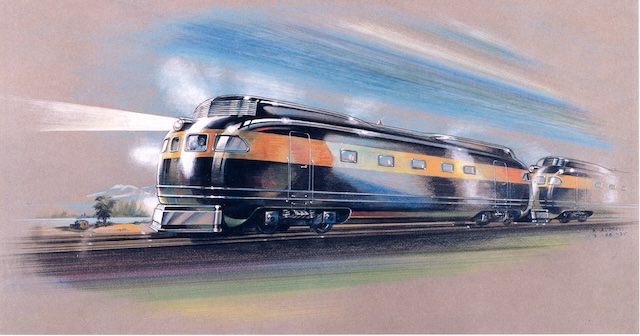
Dated March 28, 1935, this early locomotive design was painted by Paul Meyer. All of the images in today’s post were graciously made available by Greg Palumbo. Click image for a larger view; click here to download a 7.0-MB PDF containing all of the GM styling images in this post.
After Ralph Budd persuaded GM that its Diesel engines could power railroad locomotives, an important question was: what would such locomotives look like? To help answer this question, GM subsidiary Electro-Motive Company paid the Art & Color Section $55,000 a year for two of its artists: Leland Knickerbocker and Paul Meyer. Although EMC would locate in La Grange, Illinois, it appears that Knickerbocker and Meyer remained in Detroit.
Two possible answers to the question of locomotive appearance were already available in the form of the Burlington Zephyr, which had been designed by the Budd Company with the help of Philadelphia architects Paul Crét and John Harbeson, and the Union Pacific M-10000, which was designed by Pullman. But these locomotives and trains were smaller than normal, plus General Motors naturally wanted its own distinctive designs.
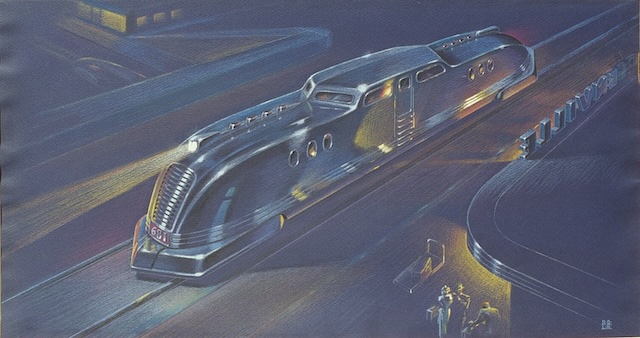
This undated locomotive design was signed “RB/LK.” LK is Leland Knickerbocker; I’m not sure who RB would be. Click image for a larger view.
Two answers developed within GM are shown above, one painted in 1935 by Paul Meyer and the other at about the same time by Leland Knickerbocker along with an unknown someone whose initials were RB. Both of these designs are heavily streamlined but are greatly at odds with what we think a Diesel locomotive should look like today. I don’t know if it is what we are used to or if later designs were simply better but the above designs seem downright ugly to me and I’m glad they were rejected.
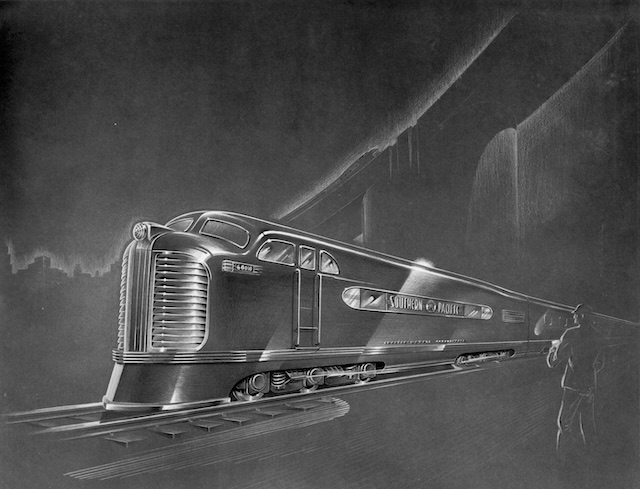
This undated locomotive design is unsigned but looks like Knickerbocker’s work. Click image for a larger view.
A third design, unsigned but probably by Knickerbocker, looks like a taller version of the locomotives used on Union Pacific’s M-10003 to M-10006 locomotives. Notice that the back of the locomotive tapers so that its rear profile matches the passenger cars that GM assumed would be about the same size as the early zephyr and city trains. As ugly as it is, replace the grill with a solid front and you have something similar to the “bulldog” nose of the early FT locomotives.
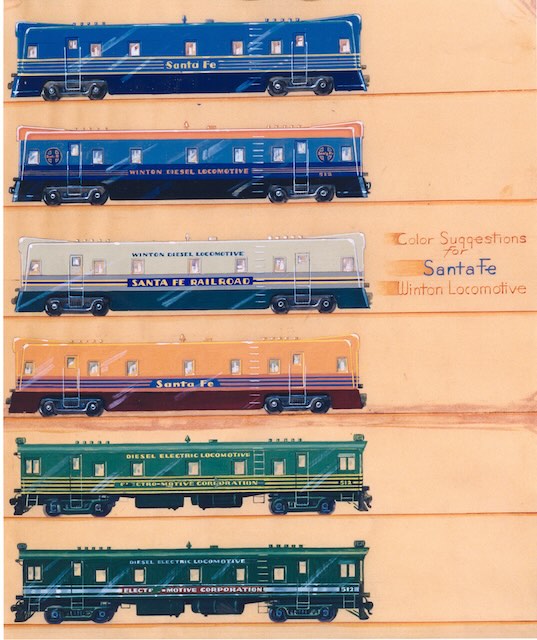 These alternative paint schemes for Santa Fe’s first Diesel-powered Super Chief were conceived by Knickerbocker. Click image for a larger view.
These alternative paint schemes for Santa Fe’s first Diesel-powered Super Chief were conceived by Knickerbocker. Click image for a larger view.
While these streamlined designed were being debated, Santa Fe wanted a locomotive for its new Budd-built Super Chief, which it would introduce in May 1936. Lacking the time or possibly the imagination to quickly come up with a streamlined locomotive, GM elected to provide a blunt-ended body and offered Santa Fe a variety of paint schemes for it. The top four locomotives in the above illustration are slightly streamlined but the final locomotive looked more like one of the bottom two.

Knickerbocker also probably painted this early image of an E1 locomotive for the streamlined Super Chief. Click image for a larger view.
Santa Fe planned more streamliners and wanted something flashier than the blunt-nosed locomotives. The above image is undated but it is beginning to resemble the E1 locomotive that would head a new Super Chief in 1937. Notice, however, that the rear truck has six wheels while the front has only four and that, like the SP locomotive, this locomotive tapers off at the rear as GM still assumed that the passenger cars would be smaller in profile. For these reasons, this image was probably made before the next two, which are closer to the final E-unit designs.
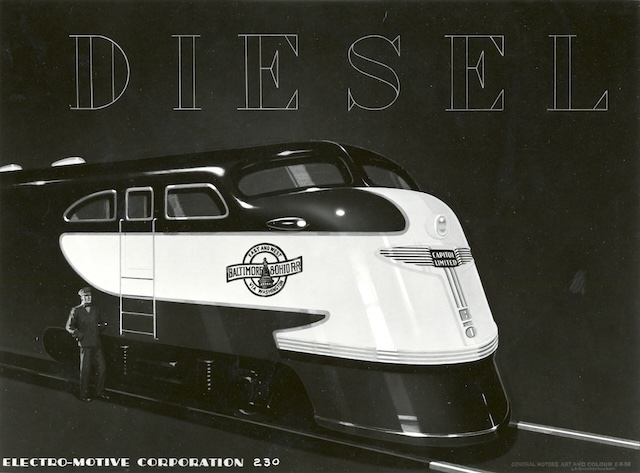
This design for the Baltimore & Ohio Capitol Limited is signed L.A. Knickerbocker and dated June 8, 1936. Click image for a larger view.
Baltimore & Ohio and Rock Island were also buying General Motors locomotives for passenger service and Knickerbocker helped with their designs. The above locomotive for the Capitol Limited finally has the classic slant-nose E unit shape. Although Knickerbocker dated this illustration in June 1936, the locomotive would not be delivered until May 16, 1937 and was not used on the Capitol Limited until 1938.
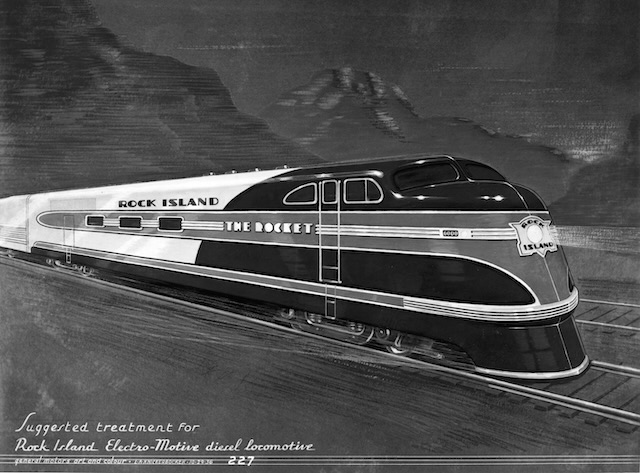
Knickerbocker dated this design for the Rock Island Rocket October 29, 1936. Click image for a larger view.
In October 1936, Knickerbocker produced the above design for the Rock Island Rockets. Although the above image is in black-and-white, it is substantially the same paint scheme as when the trains were introduced on September 19, 1937.
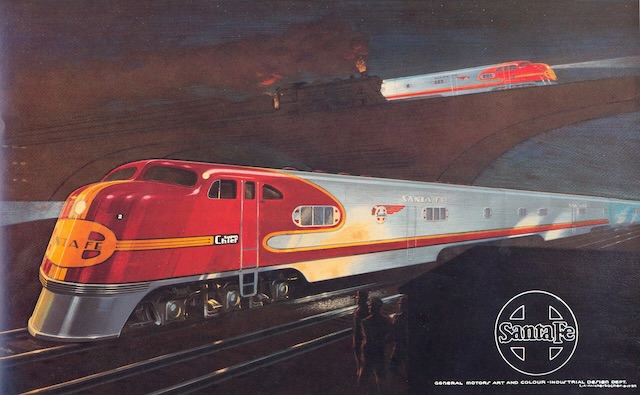
Knickerbocker dated this image of the famous Santa Fe Warbonnet February 17, 1937, just three months before the actual locomotives went into service. Click image for a larger view.
The Santa Fe Warbonnet paint scheme first appeared in the above painting that has made Knickerbocker famous and that became an iconic symbol of the Santa Fe for the rest of its corporate life. While the painting is dated after the ones for the Capitol Limited and Rockets, the locomotive it represents entered into service first, on May 18, 1937.
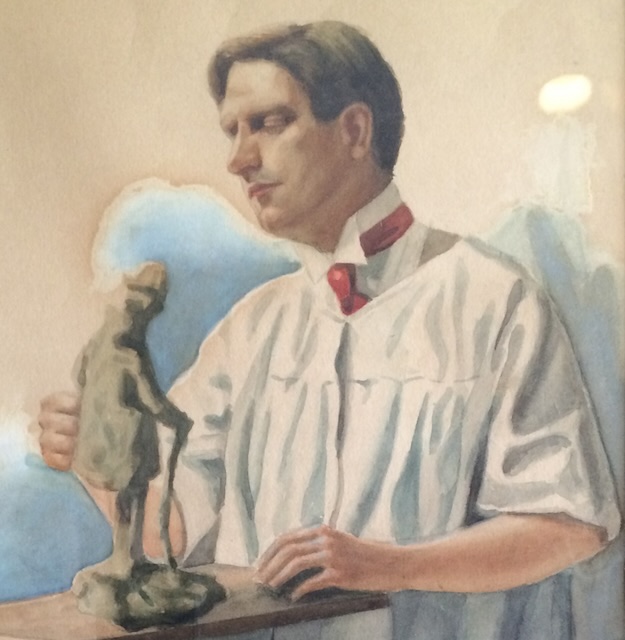 Knickerbocker painted this self portrait in 1924, when he was about 31 years old. Click image for a larger view.
Knickerbocker painted this self portrait in 1924, when he was about 31 years old. Click image for a larger view.
Unfortunately, we have only a little information about Knickerbocker himself. Leland Adelbert Knickerbocker was born in Holley, New York, which is near Rochester, in March of 1893. His parents were Adelbert Brigham Knickerbocker and Charity Fowler Knickerbocker. In 1916, he married Julia Belle Bailey and they had a daughter named Yvette.
The only image anyone seems to have of Knickerbocker is a self-portrait painted in 1924, when he was illustrating books, sculpting, and doing other art in New York. After being hired by GM Art & Color prior to 1930, he moved to Detroit where he must have helped design some General Motors automobiles, though we don’t know what.
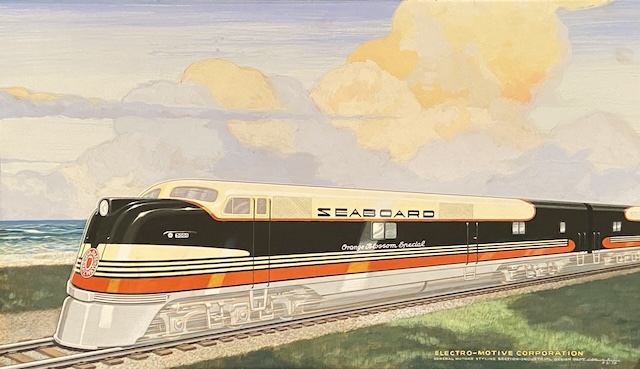
Knickerbocker painted the above image of his idea for Seaboard’s Diesel paint scheme on March 2, 1939, just three months before he passed away. Click image for a larger view.
After designing the Warbonnet, he designed the paint scheme for Seaboard Air Line’s first Diesels, which he colored yellow, green, and orange to represent the lemon, lime, and orange citrus fruits grown in Florida. In June, 1939, just two years after the Warbonnet paint scheme was first used and three months after he painted the above picture, he died at the age of 46 in Detroit (which is why I suspect he never lived in La Grange). I can’t find any information about the cause of death, but judging from the Seaboard design, he seemed to be healthy just a few months earlier.
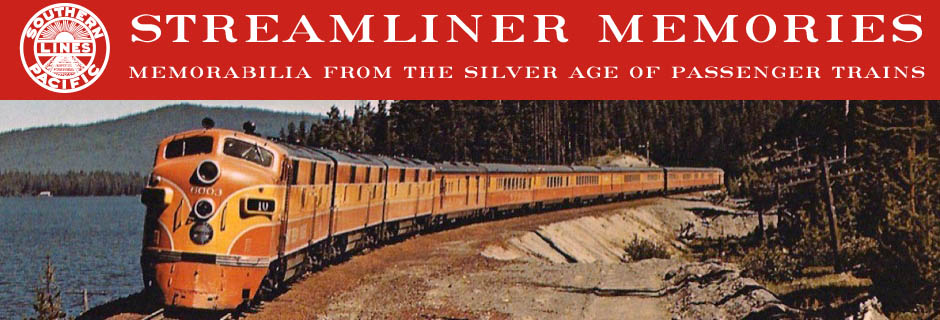
The top two designs would not be appealing at all on any number of levels: aesthetic, practical, and likely financial. Yes, I get it that Art Deco was the thing in the 1930s, but notice that the DC-3 was a straightforward expression of what it was: a flying machine. Knickerbocker’s design also anticipates bi-directional running, which was probably considered a needless add-on back then, except for switching engines. Finally, accessibility of the internal areas of the locomotives would be an issue.
All that said, “I’m Harley Earl and I’ve come back to build you a great car.”